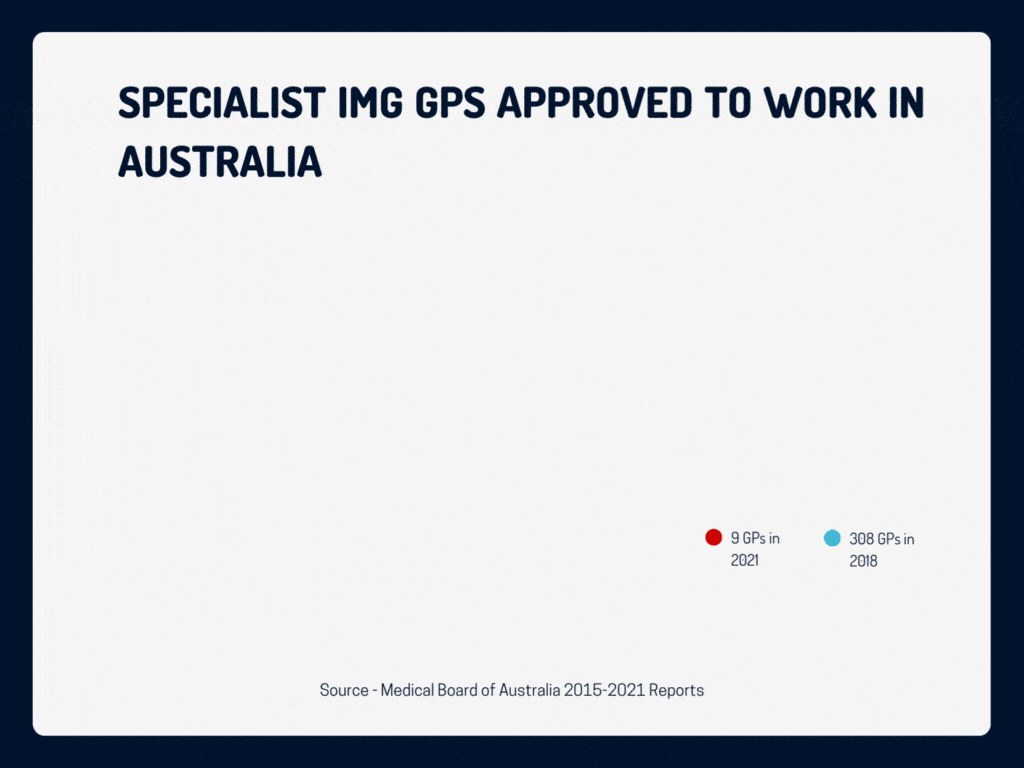Over the past few weeks, there has been a number of media articles about a growing crisis in General Practice in Australia, including this informative article in the SMH. 2 significant pieces of government information landed this week which help to shine further light on why General Practice is in crisis in Australia.
Tax Office Data Shows General Practice Falling Behind Other Specialties
The first piece of data came from the Australian Taxation Office which showed that for the financial year 2019-2020 incomes for general practitioners, whilst relatively healthy compared to other occupations in Australia continue to lag well behind all other medical specialties in Australia, apart from Pathologists. This information has been well reported in the media.
Medical Board Report Explicitly Shows That General Practice is in Crisis and on a Steep Downward Trajectory.
Some even more interesting information that has been missed by the mainstream media so far is that this week the Medical Board of Australia finally delivered its annual report on the assessment of Specialist International Medical Graduates for entry to work in Australia for 2021.
This report documents how each specialty college, including the 2 specialist General Practice colleges, in Australia assesses specialist doctors from other countries (SIMGs) in terms of their comparability to the equivalent Australian specialist under what is termed the Specialist Pathway. This assessment, therefore, determines the suitability of SIMGs to practice and apply to work in Australia.
As someone who regularly assists SIMG doctors with the process in Australia. I regularly monitor these reports. And for 2021, I was prepared to see that there had been a reduction in the number of applications and assessments for SIMGs. But even I was blown away by what this report revealed.
The number of assessments and approvals of SIMGs was significantly down across the board. Between the years 2015 and 2021, the average number of SIMG doctors deemed as comparable (and therefore eligible to apply for work as a specialist in Australia) across all specialties was 590 Specialist IMGs.
In the year 2020 which was the first year to be affected by COVID-19 this number took a small dip down to 491 SIMGs approved as comparable. But in 2021 this number has crashed to only 177 SIMGs being approved!
Only 9 International Doctors Were Approved to Work as General Practitioners in Australia in 2021.
For General Practice the picture has become even dimmer. In 2020 84 Specialist IMG GPs approved as comparable across the 2 general practice colleges. In 2021 this number sunk even lower to just 9 overseas trained GPs approved to seek employment in Australia!!
To me, this is the strongest indicator or confirmation to date that General Practice is in Crisis in Australia.

This number of only 9 Specialist IMG GPs comes off a high water mark of 308 approvals in 2018. If you look at the graphic below you will see that normally Australia relies on around 200 to 300 General Practitioners from overseas being approved to work in Australia under the Specialist Pathway under its strategy of providing a sufficient general practice workforce.
What is most worrying on this graph is that even before 2020, there was a significant dip in approvals in the year 2019. The message here is that it would be foolhardy just to attribute the current concerns about the General Practice workforce to the impacts of COVID-19.
We need to understand the reasons why both overseas trained doctors and Australian medical graduates are not embracing General Practice as a specialty in the numbers that they used to and which we need them to.
A long-term freeze on the indexation of Medicare billing items has undoubtedly hurt General Practice more than other specialties as it is generally more difficult for GPs than other specialists to charge gap fees in order to keep up with the costs of running a practice.
Regular government changes to the processes of alternate pathways for IMG doctors to enter General Practice, such as the phasing out of the General Practice Experience Pathway for the new Fellowship Support Program also cause confusion.
The Australian General Practice Training Program, which is the main program by which Australian medical graduates can train to become a General Practitioner is also undergoing significant change in 2023. Moving responsibility for training from the previous Regional Training Providers back to the Specialist General Practice Colleges. Hopefully, this change will be as smooth as possible and not lead to further disruption in this vital workforce.








Thanks Anthony, insightful as always.
The situation highlights the need to reevaluate our priorities and reshape the narrative around General Practice in Australia. As the first line of defense in our healthcare system, general practitioners deserve a fair share of the spotlight and resources. Let’s tap into our collective creativity to champion General Practice and transform it into a flourishing and sustainable cornerstone of Australian healthcare.
Troy